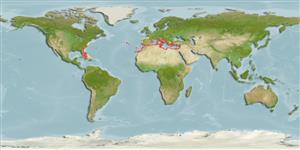Common names from other countries
Environment: milieu / climate zone / depth range / distribution range
Ecología
Asociado a arrecife. Tropical; 46°N - 21°N, 82°W - 37°E (Ref. 847)
Eastern Pacific, Atlantic Ocean and the Mediterranean. Tropical and subtropical.
Length at first maturity / Tamaño / Peso / Age
Maturity: Lm ? range ? - ? cm
Usually azooxanthellate in the Mediterranean but zooxanthellate in American coast. Colonies are encrusting or nodular and is usually red, pink, grey or green, partly depending on the presence of zooxanthellae.
Found in deep water (Ref. 847) but can be found in shallow waters (Ref. 122680), particularly in infra- and circalittoral zones (Ref. 85338).
Life cycle and mating behavior
Madurez | Reproducción | Puesta | Huevos | Fecundidad | Larva
Members of the class Anthozoa are either gonochoric or hermaphroditic. Mature gametes are shed into the coelenteron and spawned through the mouth. Life cycle: The zygote develops into a planktonic planula larva. Metamorphosis begins with early morphogenesis of tentacles, septa and pharynx before larval settlement on the aboral end.
Veron, J.E.N. 2000. (Ref. 847)
IUCN Red List Status (Ref. 130435)
CITES status (Ref. 108899)
Not Evaluated
Human uses
| FishSource |
Herramientas
Fuentes de Internet
Estimates based on models
Preferred temperature
(Ref.
115969): 13.5 - 26.4, mean 16.3 (based on 167 cells).
Price category
Unknown.
